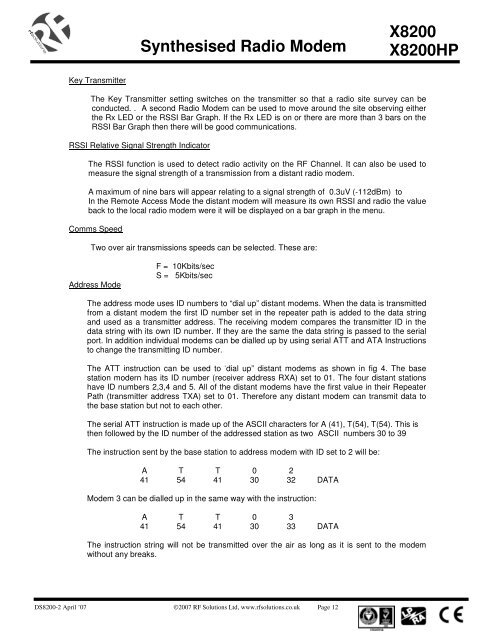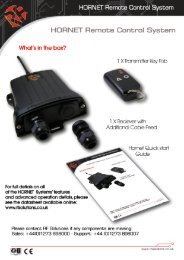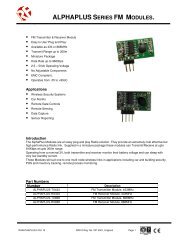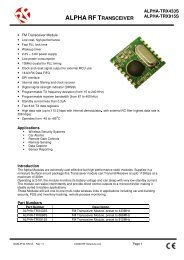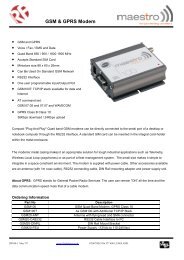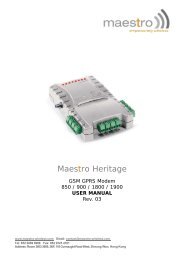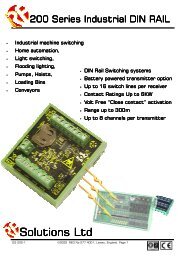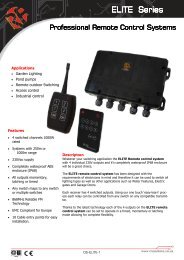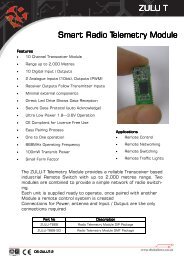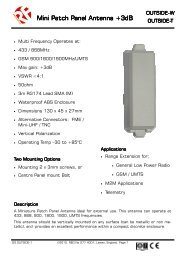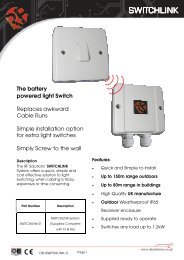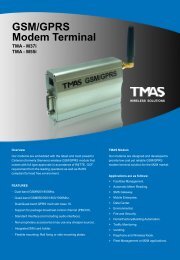Synthesised Radio Modem X8200 X8200HP - RF Solutions
Synthesised Radio Modem X8200 X8200HP - RF Solutions
Synthesised Radio Modem X8200 X8200HP - RF Solutions
You also want an ePaper? Increase the reach of your titles
YUMPU automatically turns print PDFs into web optimized ePapers that Google loves.
<strong>Synthesised</strong> <strong>Radio</strong> <strong>Modem</strong><br />
<strong>X8200</strong><br />
<strong>X8200</strong>HP<br />
Key Transmitter<br />
The Key Transmitter setting switches on the transmitter so that a radio site survey can be<br />
conducted. . A second <strong>Radio</strong> <strong>Modem</strong> can be used to move around the site observing either<br />
the Rx LED or the RSSI Bar Graph. If the Rx LED is on or there are more than 3 bars on the<br />
RSSI Bar Graph then there will be good communications.<br />
RSSI Relative Signal Strength Indicator<br />
The RSSI function is used to detect radio activity on the <strong>RF</strong> Channel. It can also be used to<br />
measure the signal strength of a transmission from a distant radio modem.<br />
A maximum of nine bars will appear relating to a signal strength of 0.3uV (-112dBm) to<br />
In the Remote Access Mode the distant modem will measure its own RSSI and radio the value<br />
back to the local radio modem were it will be displayed on a bar graph in the menu.<br />
Comms Speed<br />
Two over air transmissions speeds can be selected. These are:<br />
Address Mode<br />
F = 10Kbits/sec<br />
S = 5Kbits/sec<br />
The address mode uses ID numbers to “dial up” distant modems. When the data is transmitted<br />
from a distant modem the first ID number set in the repeater path is added to the data string<br />
and used as a transmitter address. The receiving modem compares the transmitter ID in the<br />
data string with its own ID number. If they are the same the data string is passed to the serial<br />
port. In addition individual modems can be dialled up by using serial ATT and ATA Instructions<br />
to change the transmitting ID number.<br />
The ATT instruction can be used to “ dial up” distant modems as shown in fig 4. The base<br />
station modern has its ID number (receiver address RXA) set to 01. The four distant stations<br />
have ID numbers 2,3,4 and 5. All of the distant modems have the first value in their Repeater<br />
Path (transmitter address TXA) set to 01. Therefore any distant modem can transmit data to<br />
the base station but not to each other.<br />
The serial ATT instruction is made up of the ASCII characters for A (41), T(54), T(54). This is<br />
then followed by the ID number of the addressed station as two ASCII numbers 30 to 39<br />
The instruction sent by the base station to address modem with ID set to 2 will be:<br />
A T T 0 2<br />
41 54 41 30 32 DATA<br />
<strong>Modem</strong> 3 can be dialled up in the same way with the instruction:<br />
A T T 0 3<br />
41 54 41 30 33 DATA<br />
The instruction string will not be transmitted over the air as long as it is sent to the modem<br />
without any breaks.<br />
DS8200-2 April ’07 ©2007 <strong>RF</strong> <strong>Solutions</strong> Ltd, www.rfsolutions.co.uk Page 12


